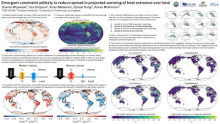Constraining the model spread in projected warming of hot days
Osamu
Miyawaki
NCAR
Poster
In response to anthropogenic emissions, hot days are projected to warm more than the mean day in the tropics. Climate models and theories have attributed amplified hot day warming to reduced surface evaporative cooling during those days. However, we currently do not have a complete understanding of the robustness of amplified hot day warming across models. Here we investigate how well proposed theories of the enhanced hot day warming explain the spatial and seasonal structure of amplified hot day warming across the CMIP6 ensemble. The results show warming of hot days are most pronounced during summertime. Additionally, models that project larger enhanced warming of hot days also project a larger decrease in surface evaporative cooling in those days. Both the spatiotemporal structure and the intermodel spread of enhanced hot day warming can be understood based on the climatological evapotranspiration regime of hot and mean days. Specifically, hot days warm more than the mean because hot days are in the water-limited regime (evaporation is sensitive to drying soil) whereas mean days are in the energy-limited regime (evaporation is insensitive to drying soil). We investigate an emergent constraint on amplified hot day warming by comparing the evapotranspiration regimes simulated by models against observational datasets.

Poster file
miyawaki-osamu-confronting-poster.pdf
(2.29 MB)
